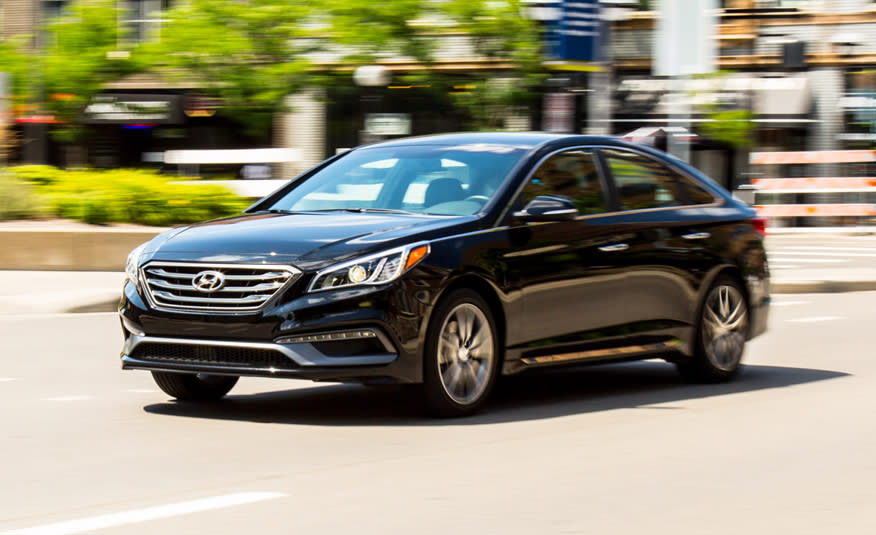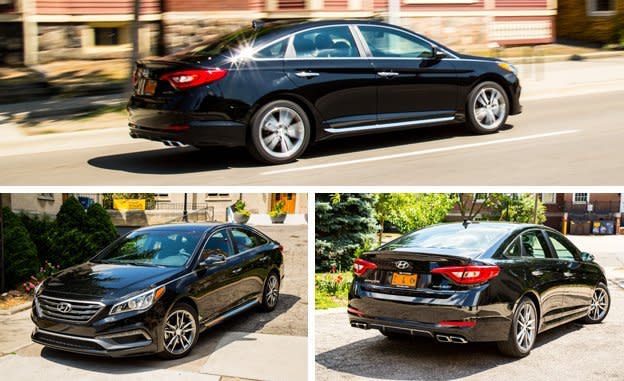2016 Hyundai Sonata Sport 2.0T

Hyundai dialed back the pizazz of the latest Sonata when it redesigned the family sedan for 2015. It’s a better all-around car and impresses with a spacious back seat and generous trunk capacity. It’s more mature-looking now, too, even if it lacks the sculpted lines of the last-generation Sonata and that car’s gusto under acceleration. We’ve previously tested the base 2.4-liter model, the top-spec 2.0T turbo, and the efficiency-focused Eco trim—as well as the updated 2016 Sonata hybrid—with the Eco being the most impressive of the conventional trio, offering both the quickest acceleration and the best fuel economy outside of the hybrid.
However, technical issues may have hobbled the performance of our previous 2.0T test car; additionally, there were notable chassis refinements that all nonhybrid Sonatas received this year, so we decided to take another look at the most powerful model in the lineup. Unfortunately, the updates didn’t deliver at the test track.

Quicker Yet Slower
A 2.0-liter turbocharged four-cylinder developing 245 horsepower and 260 lb-ft of torque powers 2.0T models like our Sport test car and is mated to a standard six-speed automatic transmission. While that’s down from the 274 ponies and 269 lb-ft of the previous-generation Sonata’s 2.0-liter, the new version is a more tractable unit, thanks to revised tuning for greater low- and mid-range punch. Our car weighed 3491 pounds, nearly 200 pounds more than the 2015 Sonata Eco with a 1.6-liter turbocharged four that produces 178 horsepower and 195 lb-ft.
The 2016 2.0T model’s 7.2-second run to 60 mph and quarter-mile pass of 15.5 seconds at 92 mph reveals that our 2015 test car, as we suspected, was not up to snuff, requiring 8.0 and 16.3 seconds to hit the same marks. The Eco, however, remains the fleetest Sonata with a 6.7-second dash to 60 and a quarter-mile time of 15.3 at 92 mph. Evidenced by the identical trap speeds for the two models, the more powerful 2.0T’s weakness is primarily in its launch performance. The Hyundai’s six-speed automatic limits the engine’s torque output if you build up any revs while holding the car against the brake, which combined with some initial lag from the turbo makes for relatively tepid takeoffs for 245 horsepower. The 2.0T’s performance also places the most powerful Sonata toward the rear of the pack versus competitors with optional V-6 or turbocharged four-cylinder engines.
The Sonata 2.0T feels more capable on the open road, where the turbo’s surge of boost around 2500 rpm makes for easy passing maneuvers whenever the driver stabs the throttle. Overall refinement is adequate for a family sedan, but we wish the power delivery were more linear—the 2.0T occasionally lunges forward under partial throttle as the torque arrives in one big surge. Calling up the more relaxed Eco driving mode softens the throttle response and the transmission programming for a smoother gait. In contrast, the Sport setting can feel overly aggressive, holding gears too long and making the throttle hair-trigger sensitive. Our test car carried EPA city/highway ratings of 23/32 mpg; we averaged 23 mpg, which is comparable to the real-world figures we’ve recorded for other family sedans. The entry-level Sonata 2.4-liter, however, returned a 27-mpg average and the Eco achieved 30 mpg with us.
Lightness Where It Counts
The open road also is where you notice the 2016 Sonata’s updated suspension: Aluminum replaces steel for the steering knuckles, the front lower control arms, and the rear upper control arms and locating links. It’s not a pronounced change, but curb weight for our Sport 2.0T test car is down more than 100 pounds versus a similar 2015 model. The 2.0T Sonatas also have a slightly stiffer, sport-tuned suspension compared with lesser models, but overall ride quality is nicely managed on all but the worst stretches of pavement.
The reduction in unsprung mass means the Sonata feels a touch more agile and responsive in corners, and slightly more feedback is transmitted through the electrically assisted power steering. The Sonata still can’t match the Mazda 6 for road feel, and it’s not as composed or as compliant on undulating roads as the Honda Accord. But Hyundai’s improvements make the Sonata a more satisfying car to drive without hampering its overall comportment.

The Sonata still struggles for cornering grip, with a tendency toward mild understeer, and the 18-inch Kumho Solus XC all-season tires (size 235/45) limit adhesion to 0.82 g around the skidpad—below the test average of our last comparison test of family sedans. The Hyundai, however, turned in a solid braking performance, stopping from 70 mph in 167 feet.
The Trade-Off
Additional changes for the 2016 Sonata are relatively minor, such as upscale Limited models receiving the Sport’s more aggressive front fascia and three-bar grille. Most 2016 versions also come with a standard 7.0-inch touchscreen center display, up from 5.0 inches, with the exception being the Limited 2.0T model getting an 8.0-inch unit. The Hyundai’s overall ergonomics are excellent, with plenty of redundant hard buttons and knobs on the simple-yet-attractive dashboard. Befitting Hyundai’s reputation for value, our test car came well equipped, with standard features including blind-spot monitoring, a rearview camera, heated leather front seats, a proximity key, dual-zone automatic climate control, Android Auto connectivity, and more.
Prices for the 2016 Sonata are up only slightly over last year, with our Sport 2.0T test car serving as the entry point for the turbocharged 2.0-liter engine. A set of carpeted floor mats for $125 was our example’s only extra, which brought the as-tested figure to a reasonable $29,885. The Eco model is a better bargain at $24,560, but be prepared to sacrifice a lot of amenities for its stronger performance. It rolls on tiny, 16-inch wheels; its body wears less jewelry; and it can’t be optioned with the numerous safety and convenience features available on Sport and Limited trims. Despite the turbocharged 2.0-liter’s range-topping status, the 1.6-liter in the Eco is quicker and more efficient—which means that in the current Sonata, performance and luxury remain mutually exclusive.
Specifications >
VEHICLE TYPE: front-engine, front-wheel-drive, 5-passenger, 4-door sedan
PRICE AS TESTED: $29,885 (base price: $29,760)
ENGINE TYPE: turbocharged and intercooled DOHC 16-valve inline-4, aluminum block and head, direct fuel injection
Displacement: 122 cu in, 1998 cc
Power: 245 hp @ 6000 rpm
Torque: 260 lb-ft @ 1350 rpm
TRANSMISSION: 6-speed automatic with manual shifting mode
DIMENSIONS:
Wheelbase: 110.4 in
Length: 191.1 in
Width: 73.4 in Height: 58.1 in
Passenger volume: 106 cu ft
Cargo volume: 16 cu ft
Curb weight: 3491 lb
C/D TEST RESULTS:
Zero to 60 mph: 7.2 sec
Zero to 100 mph: 18.5 sec
Zero to 120 mph: 30.5 sec
Rolling start, 5–60 mph: 7.7 sec
Top gear, 30–50 mph: 3.7 sec
Top gear, 50–70 mph: 5.0 sec
Standing ¼-mile: 15.5 sec @ 92 mph
Top speed (C/D est): 150 mph
Braking, 70–0 mph: 167 ft
Roadholding, 300-ft-dia skidpad: 0.82 g
FUEL ECONOMY:
EPA city/highway driving: 23/32 mpg
C/D observed: 23 mpg

 Yahoo Autos
Yahoo Autos 